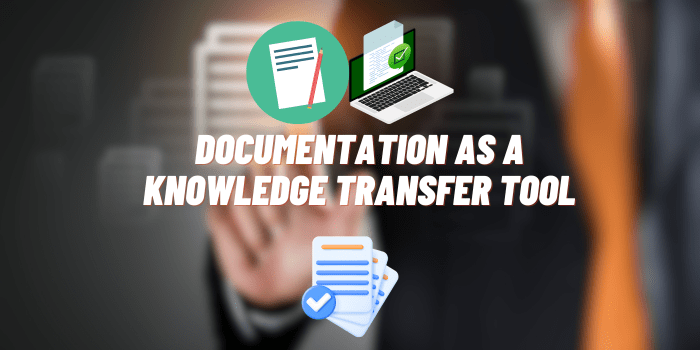Documentation as a Knowledge Transfer Tool: Onboarding and Training New Team Members
In the fast-paced realm of business, ensuring the effective onboarding and training of new team members is paramount for the seamless functioning of any organization. Among the myriad tools at our disposal, technical documentation in software development emerges as a hidden gem, often underestimated but profoundly valuable. In this comprehensive exploration, we delve into the multifaceted role of technical documentation in software development as a knowledge transfer tool, shedding light on its pivotal significance in the processes of onboarding and training.
The Power of Documentation

In the context of a company, documentation encompasses the meticulous creation and ongoing maintenance of written records that intricately outline numerous facets of the organization’s operations, processes, and procedures. These invaluable records can manifest in diverse formats, ranging from traditional manuals and informative guides to comprehensive standard operating procedures (SOPs) and even digitally accessible content. These documents serve as the informational backbone of the company, offering a comprehensive and structured resource for team members to reference and utilize in their daily tasks and decision-making processes.
Enhancing Onboarding
When a fresh addition to the team embarks on their journey within an organization, they frequently find themselves inundated with an abundance of information. This deluge of data can be not only overwhelming but also a potential obstacle to their swift integration into the team and the company’s operations. This is precisely where documentation emerges as an invaluable asset.
- Comprehensive Onboarding Manuals: Within the realm of onboarding, well-structured manuals serve as indispensable tools. These meticulously crafted resources ensure that new recruits gain access to a comprehensive repository of essential information regarding their roles, responsibilities, and the rich tapestry of the company’s culture. From understanding their job descriptions to immersing themselves in the ethos of the organization, these manuals provide a holistic view that aids in a seamless integration process.
- Efficient Training: In the realm of training, documentation takes on an equally crucial role. It acts as a guiding beacon, streamlining the entire training process. Through the provision of lucid and concise instructions, coupled with comprehensive guidelines, documentation becomes the linchpin that expedites the learning curve for new employees. This, in turn, empowers them to grasp complex concepts swiftly and embark on a path to productivity sooner than they might have otherwise.
In essence, documentation transcends its role as a mere information repository; it emerges as the bridge that connects new team members to their roles and responsibilities, the company’s culture, and the world of efficient, productive contributions.
Facilitating Training

Beyond its role in onboarding, documentation assumes a pivotal position in the continuous training and development endeavors within an organization, serving as an enduring beacon of guidance and knowledge.
- Continuous Learning: The act of learning doesn’t cease after the onboarding phase; it is an ongoing, dynamic process. Here, documentation, when consistently updated, assumes the role of a compass that guides team members through the ever-evolving landscape of industry trends, best practices, and company policies. By providing up-to-date information, documentation equips employees with the tools and insights they need to remain at the forefront of their respective fields, fostering a culture of perpetual learning and improvement.
- Problem-Solving: In the face of challenges, documentation emerges as a trusted troubleshooter. It stands ready as a reliable guide, offering step-by-step solutions to address common issues and hurdles that may arise in day-to-day operations. This not only aids in resolving immediate concerns but also nurtures problem-solving skills among employees. By encouraging individuals to independently navigate and conquer challenges, documentation fosters a sense of self-reliance and resourcefulness, ultimately contributing to a more resilient and adaptable workforce.
In essence, documentation extends its influence beyond initial training; it serves as an enduring resource that empowers employees to embark on a journey of continuous learning and become adept problem solvers, thereby enhancing the overall efficiency and effectiveness of the organization.
Active Voice and Clarity
To maximize the efficacy of documentation as a conduit for knowledge transfer, it becomes imperative to adhere consistently to the use of an active voice throughout the entirety of the content. This approach not only ensures the information’s conciseness but also upholds its clarity and straightforwardness.
Employing an active voice means that the subject of the sentence is the one performing the action, which imparts a sense of immediacy and directness to the communication. By embracing this approach, documentation becomes a vehicle through which information is conveyed with precision and transparency, leaving little room for ambiguity or confusion. Consequently, team members can access and assimilate the information more readily, thereby facilitating a smoother and more effective knowledge transfer process.
Transition Words for Smooth Flow

Transition words play a crucial role in upholding the coherence and structure of a document, ensuring that the flow of information remains seamless and logical. Here, we provide a comprehensive list of transition words that you can incorporate into your documentation to enhance its clarity and readability:
- Firstly: This word is ideal for introducing the initial point or idea in your content, setting the stage for what follows.
- Moreover: Use “Moreover” when you want to add another point that supports or complements the previous one, reinforcing the overall message.
- Furthermore: Similar to “Moreover,” “Furthermore” signifies an additional point or aspect that strengthens the argument or narrative.
- In addition: When you want to introduce something extra, “In addition” is the perfect choice, signaling that there’s more to come.
- Consequently: Use “Consequently” to indicate a cause-and-effect relationship, showing how one idea or action leads to another.
- Therefore: This word signifies a logical conclusion or result based on the preceding information, making it a valuable addition for conveying the implications of your points.
- To illustrate: When you wish to provide an example or offer further clarification, “To illustrate” helps in elaborating on a concept.
- For instance: Similar to “To illustrate,” “For instance” is ideal for presenting specific examples that bolster your arguments or explanations.
- In summary: When you’re wrapping up a section or summarizing key points, “In summary” serves as a handy transition to bring your content to a close.
By judiciously incorporating these transition words into your documentation, you can ensure that your content maintains a logical and fluid structure, guiding readers effortlessly from one idea to the next, while also enhancing overall readability and comprehension.
Conclusion
In conclusion, documentation is an indispensable tool for the onboarding and training of new team members. It acts as a bridge between existing knowledge and newcomers, ensuring a seamless transition. By following a clear and active writing style, along with the judicious use of transition words, you can create documentation that truly serves its purpose. In the dynamic world of business, investing in effective documentation is a step toward long-term success.






